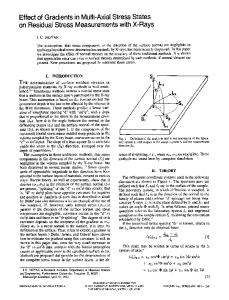Experimental Measurements of Surface Residual Stress Caused by Nano-scale Contact of Rough Surfaces
- PDF / 146,343 Bytes
- 6 Pages / 612 x 792 pts (letter) Page_size
- 14 Downloads / 342 Views
U9.9.1
Experimental Measurements of Surface Residual Stress Caused by Nano-scale Contact of Rough Surfaces J. Wang, P. Shrotriya, H.H. Yu and K.-S. Kim Division of Engineering, Brown University, Providence, RI 02912 ABSTRACT A previous dislocation model analysis predicts that nano-scale contacts of surface steps induce nucleation of dislocations leading to pro-load and anti-load dislocation segregation near the contact surface. Such dislocation segregation generates a sub-layer of tensile residual stress in a much thicker layer of compressive residual stress near the surface. The sub-layer thickness is expected to be about 50 to 100 times the step height. In order to verify the predictions of the model analysis, experiments are carried out on polycrystalline aluminum surface to determine the existence of the tensile sub-layer. The variation of the residual stress along the thickness direction is measured using a newly developed high sensitivity curvature-measurement interferometer. The interferometer measures the curvature change of the back surface of a plate specimen of about 1.9 mm thickness while the contact-loaded front surface is chemically etched. The residual stress distribution measured with sub-nanometer spatial resolution is compared with analytical predictions. INTRODUCTION When two rough surfaces are in contact, significant wear occurs due to contact pressing and sliding between the two surfaces. The rate of wear is a function of many parameters including normal force, sliding velocity, temperature, thermal, mechanical and chemical properties of the contact material. And it involves many different mechanisms. Empirical diagrams of wearmechanisms reveal that at low sliding region, which is the typical working condition for gears, brakes and clutches during the operation of an automobile, plasticity-dominated delamination wear plays the most important role [1]. Thus the understanding of the mechanisms of delamination wear has been highly valued by the wear community. Among the many causes of delamination wear, surface roughness plays an important role [2-5]. When two rough surfaces are brought together, local yielding and the subsequent localized damage and wear occur at surface asperities far before the system reaches its bulk yielding condition. The relation between surface roughness and wear rate has been studied by many researchers. Most of the previous studies, however, relied on the empirical knowledge constructed from experimental data, with little understanding of the source and mechanisms. Recently, an effort toward the understanding of the real mechanisms governing plastic deformation of contact surfaces was initiated in the current researchers’ group. A dislocation based unit process model consisting of a surface with one step in contact with a flat rigid surface was used to study surface roughness evolution under contact loading [6]. Rice-Thomson’s dislocation nucleation criterion [7] was used to model the dislocation nucleation from the surface step. Under contact load, a dislocation nucleat
Data Loading...










